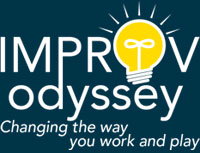FOCUS – Process Creates Story
More commentary on Spolin’s Tips and Pointers
Pointer # 9 – The energy released in solving the problem, flowing through the Where, Who, and What, forms the scene.
Taken from “Improvisation for the Theater” by Viola Spolin; 3rd Edition, Northwestern University Press.
Solving a challenging problem constitutes a strong FOCUS. Viola Spolin used to call it the P.O.C. – Point of Concentration but later changed it to FOCUS. “POC is static.” she told me “Focus”is not static. It is constantly in motion in relation to the players.”
Focus concentrates all the players’ skills and effort and creativity, and that makes for great Improvisation. Trying to stay on FOCUS generates energy (the power) needed for playing. When it is channeled and flows through the given structure (short or long form) to shape the real live event- drama is created. An eleven year-old student once said to me, “It takes all your strength to stay on FOCUS.”
“That is the point!” I told her. “That’s why it’s fun.” And that’s what improvisation is all about.
Story comes into being in the wake of seeking a solution to a problem. Finding the story any other way constitutes being in your head. Creating narrative through things like a story spine is a technique that writers use. Keeping the focus of improvising a story is a mistake. Creating story by adding information and accepting all offers is a kind of authoring process. It is playwriting.
It often comes from the head and does not have the dynamic power of watching a group of people solve a particular problem or set of problems intuitively: The intuition being that facility that unifies intellect with action spontaneously to create energy, drama, and the excitement of discovering solutions in the moment from an unknown place.
A Yes, and… imperative calls on the actors to add some unusual information to the mix and incorporating that information becomes the problem. The sorting and integration of that information is usually the focus in a long form. When finding story IS the problem, as is the case in most long form improv, the only thing that sets up something worth watching is when actors give each other various smaller problems to solve within the scene. I.e., a tilt (plot) or unusual piece of information or introducing a new character.
I grant that solving those problems is a legitimate focus, but with the continual addition of information, little time is left for true connection. The Where does not get developed, and players rely mostly on the unfolding story which is often mistaken for the FOCUS. Story comes mostly from playwriting quickly. In many improv groups the writer/performers of the group emerge as the best improvisers because they are faced with making something from all that information. Playwriting kills true spontaneity because it must come from old frames of reference. Players need to share that common reference and rely on the audience knowing it too. Clever actors do indeed incorporate this information and can make some good comedy from it, but is lacking something – stepping into the unknown together. The real magic of Improv.
It is fun to see comedy Improv, but it can only be clever. This relegates Improv to something less than it can be. It certainly doesn’t have to be so.
I believe creating story should not be the primary focus in improv work. Story is a trap. Rather allow story to emerge from a solid focus that keeps everyone engaged in seeking its solution. Story being the result of that process and not the goal.
Viola once told me “Focus is the tail of the comet. What’s left behind is stardust.” And she’d laugh.

